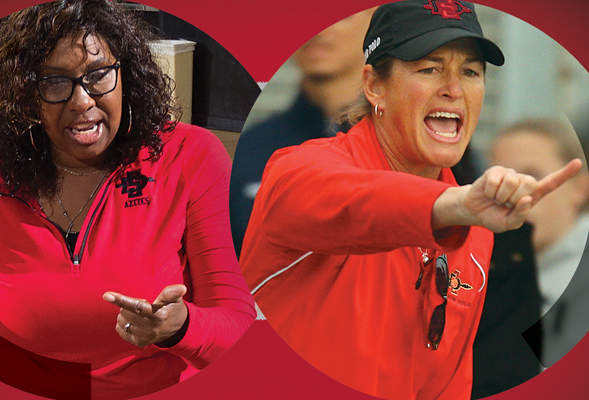The Ball's in Her Court
SDSU bucks a trend with women coaching most womens sports.

This is an abridged version of a story that appears in the spring 2019 issue of 360: The Magazine of San Diego State University, due out March 21.
Across U.S. campuses, female athletes crushing track and field records or driving for a spot in March Madness are more likely than not to be coached by a man.
With women heading eight of 12 women’s teams, San Diego State University is challenging the invisible barriers that exist, even in women’s sports. The university ranks in the top 20 among NCAA Division I institutions in the hiring of women coaches.
Jenny Bramer, the Aztecs’ executive associate athletic director, is proud of SDSU’s leadership in this arena. Over the past 15 years, she’s worked hard to search out stellar women candidates for head coach openings.
“The key to hiring women is recruitment,” Bramer says. “We’ve had a lot of men who apply for coaching jobs; we’ve had to go find women.”
Once upon a time, nearly all intercollegiate sports played by women were coached by women. Then along came Title IX, the 1972 law prohibiting sex discrimination in federally funded educational programs. A decade later, the NCAA accepted women’s sports.
Progress, right? Yes and no. With the boost in prestige and funding, women’s sports became a viable career path for male coaches, most of them recruited and hired by male athletic directors from within mostly male professional networks.
Even today, at NCAA Division I schools, men coach nearly 60 percent of women’s teams, according to the University of Minnesota’s Tucker Center for Research on Girls and Women in Sports.
“It’s amazing to me that there’s been such progress for women, and yet in coaching we’ve gone backwards,” said Carin Crawford, the long-time head coach of SDSU women’s water polo. In her sport, only 20 percent of top coaches are women.
Whether consciously or not, student athletes notice such glaring disparities, which shape their assumptions about the world of college sports—and often their own potential. Women athletes who never see a woman coach may never think of coaching as a possible career, no matter how well they play or how much they love their sports. Things change when administrators bring women into leadership.
“We have a saying in women’s sports,” Bramer said. “If I can see her, I can be her.”
Johnna Fouch offers proof. She’s a fast-tracking 2014 SDSU graduate who just became head volleyball coach at Eastern Kentucky University.
Fouch grew up with a powerful female role model—her mom, a high school athletic director. But it was Aztecs volleyball head coach Deitre Collins-Parker who inspired Fouch’s career choice.
“Our volleyball team had an all-woman staff my senior year. I loved that experience and wanted to pass it on to other students, which is why I got into coaching,” Fouch said.
Collins-Parker also helped Fouch find her first job. “I wouldn’t be here at Eastern Kentucky if it weren’t for Deitre mentoring me and reaching out to coaches,” Fouch said.
As women coaches strengthen their professional networks and ascend to top jobs, they tend to hire other qualified women and introduce policies that help retain them.
Bramer made clear that the best candidate to lead athletic teams can come from any gender.
“What we’ve done,” she explained,” is go out and actively search for women who may be that person.”



